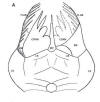|
 |
- Body very small: 0.2-0.4 mm
- Cuticls triated, with short scattered setae
- Wide, non-striated cephalic expansion; anteriaor with fimbtiate
flabellae
- Lamelliform cornua, each with four tines; lateral edges not
fimbriate
- Amphids ciruclar or unispiralat mid-level of cylindrical stoma
- Esophagus plectoid with valved posterior bulb.
- Tail conoid-cylindroid, slightl curved to ventral side
- Caudal glands and spinneet present
Females:
- Head with dorsal and ventral flanges.
- Diovarial; ovaries outstretched, vulva at mid-bodu
- Setae along body .
- Thick cuticle.
- Plectid esophagus with terminal, valved
postcorpus.
- Two lines
in lateral
field.
|
 |
 |
 |
Males:
- Very uncommon
- Diorchic
- No gubernaculum or ventromedian supplements
|
 |
|
Photographs by H. Ferris. Specimens from soil-litter interface, UC Davis
campus.
|
 |
Labial
region components of Wilsonema
from Holovachov et al., 2003.
CE = cervical expansion, CORN = cornu; FLAB = flabellum; LR = lateral rim;
MP = midlateral projection; MR = median ridge; QUAD = quadrant; RR = radial
ridge; YI = Y-shaped incisure.
For comparisons among genera, go to subfamily
Wilsonematinae |
|
|
Reported world-wide.
Holovachov, O., Bostrom, S., Tandingan De Ley, I., De Ley, P., and Coomans,
A. 2003. Morphology and systematics of the genera Wilsonema Cobb, 1913,
Ereptonema Anderson, 1966 and Neotylocephalus Ali, Farooqui
and Tejpal, 1969 (Leptolaimina: Wilsonematinae) J. Nem. Morph. Syst. 5:73-106.